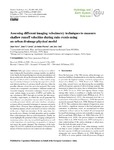Assessing Different Imaging Velocimetry Techniques to Measure Shallow Runoff Velocities During Rain Events Using an Urban Drainage Physical Model

Ver/Abrir
Use este enlace para citar
http://hdl.handle.net/2183/27739Colecciones
- Investigación (ETSECCP) [826]
Metadatos
Mostrar el registro completo del ítemTítulo
Assessing Different Imaging Velocimetry Techniques to Measure Shallow Runoff Velocities During Rain Events Using an Urban Drainage Physical ModelFecha
2021Cita bibliográfica
Naves, J., García, J. T., Puertas, J., and Anta, J.: Assessing different imaging velocimetry techniques to measure shallow runoff velocities during rain events using an urban drainage physical model, Hydrol. Earth Syst. Sci., 25, 885–900, https://doi.org/10.5194/hess-25-885-2021, 2021.
Resumen
[Abstract] Although surface velocities are key in the calibration of physically based urban drainage models, the shallow water depths developed during non-extreme precipitation and the potential risks during flood events limit the availability of this type of data in urban catchments. In this context, imaging velocimetry techniques are being investigated as suitable non-intrusive methods to estimate runoff velocities, when the possible influence of rain has yet to be analyzed. This study carried out a comparative assessment of different seeded and unseeded imaging velocimetry techniques based on large-scale particle image velocimetry (LSPIV) and bubble image velocimetry (BIV) through six realistic but laboratory-controlled experiments, in which the runoff generated by three different rain intensities was recorded. First, the use of naturally generated bubbles and water shadows and glares as tracers allows unseeded techniques to measure extremely shallow flows. However, these techniques are more affected by raindrop impacts, which even lead to erroneous velocities in the case of high rain intensities. At the same time, better results were obtained for high intensities and in complex flows with techniques that use artificial particles. Finally, the study highlights the potential of these imaging techniques for measuring surface velocities in real field applications as well as the importance of considering rain properties to interpret and assess the results obtained. The robustness of the techniques for real-life applications yet remains to be proven by means of further studies in non-controlled environments.
Palabras clave
Surface water velocities
Physically based urban drainage models
Shallow depths
Floods
Velocimetry techniques
Water runoff
Physically based urban drainage models
Shallow depths
Floods
Velocimetry techniques
Water runoff
Versión del editor
Derechos
Atribución 4.0 Internacional






